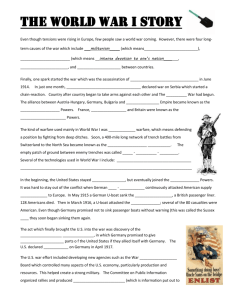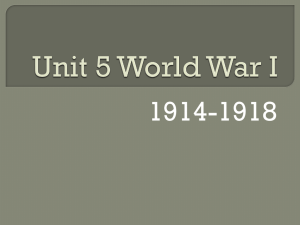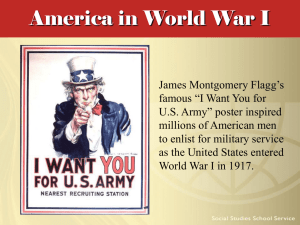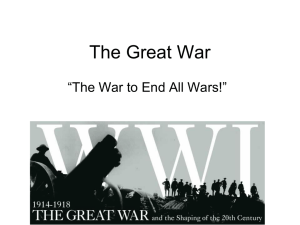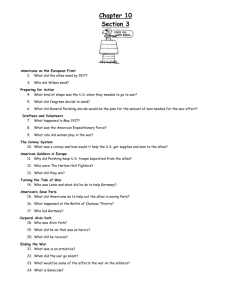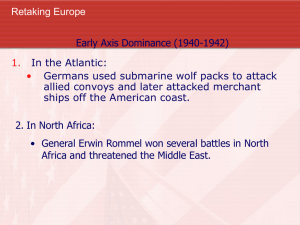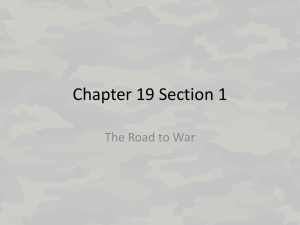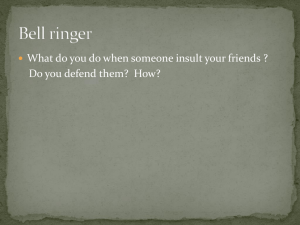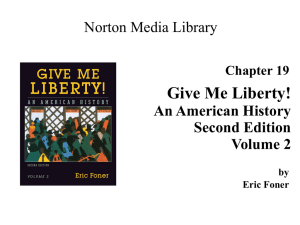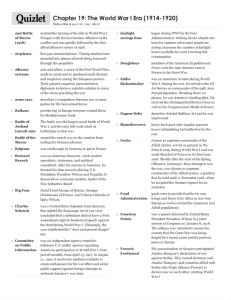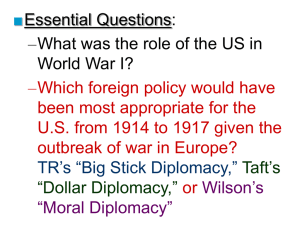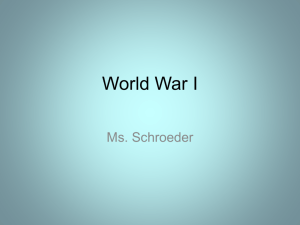Chapter 24 Study Guide
advertisement
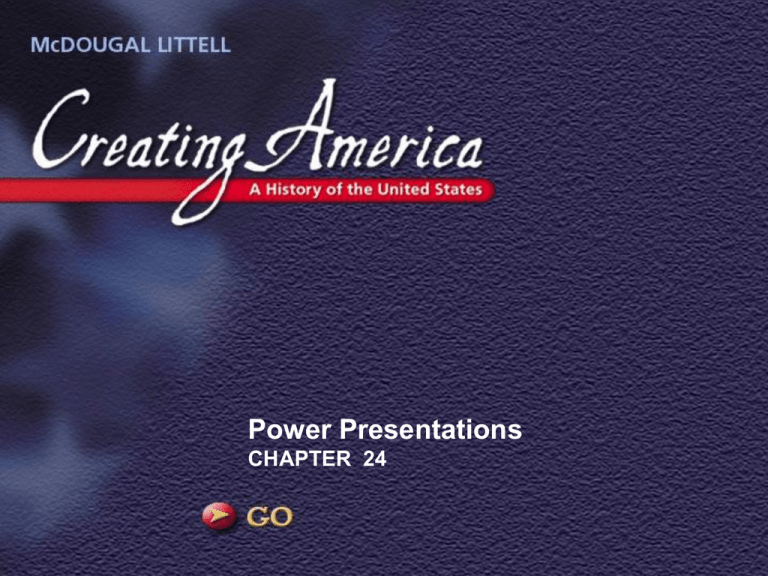
Power Presentations CHAPTER 24 America in the World Image The year is 1918, and the United States has been drawn into World War I. Each citizen is called upon to help the war effort. Some will join the American armed forces and go to fight in Europe. Others will work in factories at home, producing weapons and supplies. Even children will do their part. How will you support the war effort? • How can Americans at home help win the war? • What might U.S. soldiers experience in Europe? • How might being at war affect the country? August 15, 1914 U.S-built Panama Canal officially opens. May 7, 1915 Many Americans die as German U-boat sinks Lusitania. November 7, 1916 Woodrow Wilson is reelected president. April 2, 1917 Wilson asks Congress to declare war on Germany. January 8, 1918 President Wilson proposes League of Nations. To World November 2, 1920 Warren G. Harding is elected president. Image June 28, 1914 Austria-Hungary’s Archduke Franz Ferdinand is assassinated, starting World War I. February–December, 1915 Allies and Central powers clash at Gallipoli in the Ottoman Empire. July–November, 1916 French, British, and Germans suffer huge losses at the Battle of the Somme. March 3, 1918 Russia withdraws from the war. November 11, 1918 The Allies defeat the Central Powers, ending World War I. June 28, 1919 The Allies and Germany sign the Treaty of Versailles. Back to U.S. Back to Home Main Idea After World War I broke out, the United States eventually joined the Allied side. Why It Matters Now This was the first time that the United States was involved in a European conflict. Map What were four events that brought the United States into World War I? Image Germany invades Belgium. U-boat sinks Lusitania. Zimmermann telegram discovered. United States enters World War I. Germany resumes unrestricted submarine warfare. • What were the long-term causes of World War I? • Why were Americans divided over the issue of remaining neutral? • Why was Russia’s withdrawal from the war in 1917 a blow to the allies? Analyzing Causes How did imperialism, nationalism, and militarism work to reinforce each other? Think About • the goals of each • how nationalism might encourage military buildup • how nationalism contributed to the race for colonies Back to Home Main Idea U.S. forces helped the Allies win World War I. Why It Matters Now For the first time, the United States asserted itself as a world power. Map How did American groups or individuals help fight the war? Women served as nurses, clerks, relief workers, ambulance drivers AEF ground troops helped push back the German line Contributions U.S. naval forces escorted merchant ships and mined the North Sea Sergeant York killed 25 enemy machine gunners and took 132 prisoners Image • Why did Wilson want U.S. forces to fight as a separate American combat unit? • What were two ways the U.S. Navy countered the U-boat threat? • Why was the Meuse-Argonne offensive a turning point in the war? Recognizing Effects How important was America’s entry into the war to the Allied cause? Think About • the morale of Allied troops • troop strength • performance in battle Back to Home Main Idea The war required sacrifice for Americans at home and changed life in other ways. Why It Matters Now Some wartime changes were permanent, such as black migration to Northern cities. What were some reasons for wartime shifts in population? Shift Reasons African Americans Moved from the South to Northern cities To gain employment and to escape the bigotry, poverty, and racial violence of the South Mexicans Moved to the American Southwest and Northern cities To gain jobs and to escape the chaos and violence of the Mexican Revolution • What were three ways American families could contribute to the war effort? • What was the purpose of the Espionage and Sedition Acts? What groups were most affected by them? • What kinds of new job opportunities did the war create for women and minorities? Making Inferences What were the positive and the negative consequences of American wartime propaganda? Think About • contributions to war effort • effect on opponents of war and on GermanAmericans Back to Home Main Idea After the war, Americans were divided over foreign policy and domestic issues. Why It Matters Now The war affected the role the United States played in the world during the rest of the century. What were the effects of the war on Europe and the United States? EFFECTS OF WORLD WAR I Europe United States Destruction and millions of deaths Political division Russian Revolution Strikes Breakup of German, Austro-Hungarian, and Ottoman empires Red Scare and Palmer raids Creation of new nations Job opportunities for African Americans, Mexicans, and women • Why did Germany resent the Treaty of Versailles? • Why did Lodge and other Republicans oppose joining the League of Nations? • What caused the Red Scare? Who was the most affected by it? Analyzing Points of View Why was Wilson unable to get other powers to accept his goals for the peace conference? Think About • conflicting goals • practicality of Wilson’s aims • attitudes of other nations towards U.S. contributions during the war Back to Home REVIEW QUESTIONS ANSWERS: READ AND TAKE NOTES 1 What were the sources of tension between the European powers that led to war? 2 Why did the United States at first remain neutral in the war between the Allies and the Central Powers? 3 What brought the United States into the war on the Allied side? 4 How did the Allies fight the German U-boat threat? 5 How did U.S. entry into the war affect the Allies? 6 What led Germany to agree to an armistice? 7 How did U.S. civilians aid the war effort? 8 How did Congress contribute to increased prejudice and intolerance on the home front? 9 How did Wilson’s goals for the peace conference differ from those of his European allies? 10 Why did the Senate reject the Treaty of Versailles? WORLD WAR I Effects on the World Effects on the United States Millions of military deaths and injuries U.S. soldiers sent abroad Civilian sacrifices Russian Revolution Spread of flu epidemic Breakup of European empires Lasting resentments among European countries Political repression and anti-German prejudice New job opportunities for women and minorities Great Migration and racial tensions Back to Home These labels let you know where you are in the presentation. When you click on the arrow you will be linked to a related visual. Map Image These buttons link you to special areas. Use these buttons to go back to the previous slide, or to move forward in the presentation. To reveal the content of a slide just press the space bar or click your mouse once. To use a button, move your pointer over the button. When your pointer becomes a hand, click your mouse. Back to Previous
